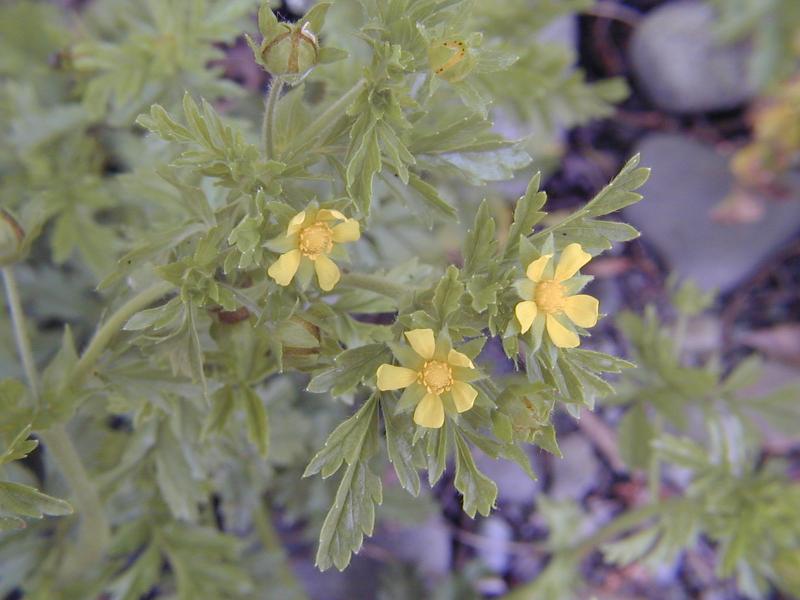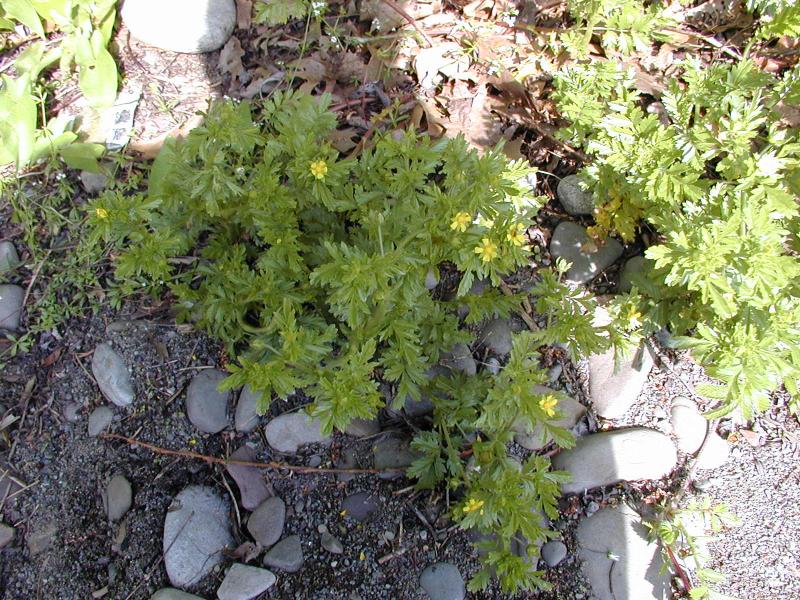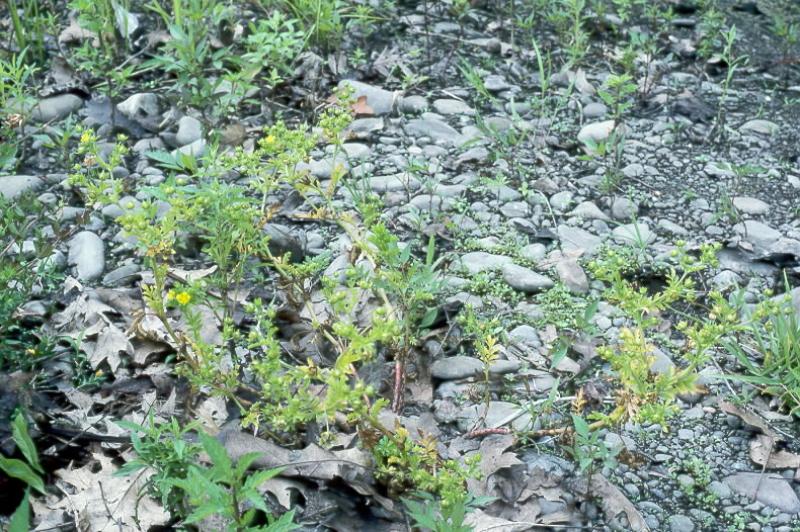Bushy Cinquefoil
Potentilla supina ssp. paradoxa (Nutt.) Sojak
- Class
- Dicotyledoneae (Dicots)
- Family
- Rosaceae (Rose Family)
- State Protection
- Endangered
Listed as Endangered by New York State: in imminent danger of extirpation in New York. For animals, taking, importation, transportation, or possession is prohibited, except under license or permit. For plants, removal or damage without the consent of the landowner is prohibited.
- Federal Protection
- Not Listed
- State Conservation Status Rank
- S1
Critically Imperiled in New York - Especially vulnerable to disappearing from New York due to extreme rarity or other factors; typically 5 or fewer populations or locations in New York, very few individuals, very restricted range, very few remaining acres (or miles of stream), and/or very steep declines.
- Global Conservation Status Rank
- G5T5
Secure globally - Both the species as a whole and the subspecies/variety are common in the world; widespread and abundant (but may be rare in some parts of its range).
Summary
Did you know?
The common name "Cinquefoil" in the Middle English Dictionary is described as "Pentafilon" (From Greek Pentaphyllon) influenced by foil, a leaf. The word is derived from Old French cinc, Middle English cink and ultimately Latin quinque, all meaning "five", and feuille and foil/foille which mean "leaf". Formerly this term referred to five-leaved plants in general. In medieval times, the word "cinquefoil" was used almost exclusively in England. In France, the genus was called quintefeuille, first attested in Normandy and Brittany in the 11th century (Wikipedia contributors). The species name means strange or paradoxical and comes from the unusual prominent corky enlarged bases of the carpels (Fernald 1970).
State Ranking Justification
There are four existing populaitions but they are all small with fewer than 30 plants each. There are six historical occurrences from the late 1800s to 1917. Most of these have not been surveyed again.
Short-term Trends
Records surveys suggest a slight decline in several of the populations over the past two decades but more survey effort is needed.
Long-term Trends
Only one of the sites was known historically so the long-term trend is unclear.
Conservation and Management
Threats
The plants may be subject to flooding, trampling by fishermen, campers, and other users of its habitat.
Conservation Strategies and Management Practices
Restrict public access to its habitat during flowering and fruiting season.
Research Needs
There are no known research needs at this time.
Habitat
Habitat
All of the New York collections of Bushy Cinquefoil have been from Lake Ontario and Lake Erie shorelines, including cobble bars, inaccessible shale outcrops, and sandy beaches. (NYHP 2013). Moist or wet soil (Gleason and Cronquist 1991). Loose sand of a barrier beach (Voss 1985). Prairies, bottoms, shores and damp places (Fernald 1950).
Associated Ecological Communities
- Cobble shore
(guide)
A community that occurs on the well-drained cobble shores of lakes and streams. These shores are usually associated with high-energy waters (such as high-gradient streams), and they are likely to be scoured by floods or winter ice floes.
- Sand beach
A sparsely vegetated community that occurs on unstable sandy shores of large freshwater lakes, where the shore is formed and continually modified by wave action and wind erosion. Characteristic species that are usually present at very low percent cover include various grasses and other herbs.
- Shoreline outcrop
(guide)
A community that occurs along the shores of lakes and streams on outcrops of non-calcareous rocks such as anorthosite, granite, quartzite, sandstone, gneiss, or schist. The shoreline is exposed to wave action and ice scour. The vegetation is sparse; most plants are rooted in rock crevices.
Associated Species
- Alnus serrulata (smooth alder)
- Amorpha fruticosa (false indigo-bush)
- Argentina anserina
- Asclepias syriaca (common milkweed)
- Cakile edentula
- Calystegia sepium (hedge bindweed)
- Centaurea stoebe
- Galium obtusum
- Geum canadense (white avens)
- Impatiens capensis (spotted jewelweed, spotted touch-me-not)
- Lycopus americanus (American bugleweed, American water-horehound)
- Lythrum salicaria (purple loosestrife)
- Medicago lupulina (black medic)
- Melilotus albus (white sweet-clover)
- Oenothera biennis (common evening-primrose)
- Phalaris arundinacea (reed canary grass)
- Phragmites australis ssp. australis
- Potentilla arguta
- Rosa palustris (swamp rose)
- Sparganium americanum (American bur-reed)
- Symphyotrichum pilosum
- Xanthium strumarium
Range
New York State Distribution
Bushy Cinquefoil is restricted to the shorelines of Lake Ontario and Lake Erie, from Cayuga county in the northeast to Chautauqua county in the southwest.
Global Distribution
Bushy Cinquefoil reaches the eastern limit of its distribution in at Lake Ontario, its range extends through all the Canadian Provinces, and through most of the Pacific Northwest and Great Plains states, south to Texas and Louisiana.
Identification Comments
General Description
Potentilla paradoxa is an annual or short-lived perennial forb with reclining (decumbent) to arching stems that often grow parallel along the ground for the first 5 cm before turning upwards, and reaching 20 to 50 cm at maturity. The leaves are mostly pinnate (occasionally with some trifoliate leaves) with 7 to 11 leaflets including 2 to 5 distant pairs of small egg-shaped (with the narrow end attached) or oblong leaflets that have rounded teeth and pointed sinuses. The flowers are borne in a leafy, open-branching, elongated, loosely clustered, round- topped inflorescence. The petals are yellow and 1.5 to 2.5 wide, with deeply notched tips, and equal or exceed the calyx, which is covered in long stiff hairs. The fruits are longitudinally-ribbed achenes with a prominent corky enlargement along the underside (Britton and Brown 1913).
Identifying Characteristics
Potentilla paradoxa is annual or short-lived perennial forb with reclining (decumbant) to arching stems that often grow parallel along the ground for the first 5 cm before turning upwards, and reaching 20 to 50 cm at maturity. The leaves are mostly pinnate (occasionally with some trifoliate leaves) with 7 to 11 leaflets including 2 to 5 distant pairs of small egg-shaped (with narrow end attached) or oblong leaflets that have rounded teeth and pointed sinuses. The flowers are borne in a leafy, open branching, elongated, loosely clustered, rounded topped inflorescence with the terminal flower first to bloom (panicled cyme). The flowers are yellow 1.5 to 2.5 wide, with deeply notched tips, and equal or exceed the calyx which is covered in long stiff hairs (hirsute). The fruits are longitudinally-ribbed achenes with a prominent corky enlargement along the underside (ventral) where the two edges join (suture). (Britton and Brown 1913)
Best Life Stage for Proper Identification
Potentilla paradoxa may be positively identified vegetatively based on leaf morphology and the plant's habitat. A description of the plant's habitat and mature fruits or flowers are preferred for positive identification, ideally in combination with the entire plant stem including intact leaves.
Similar Species
Potentilla norvegica may resemble a dwarfed P. paradoxa. Potentilla norvegica has 3 leaflets, never more. The achenes are usually ridged. It is found in a wide variety of habitats, including the wet sand, wet rock, and shorelines indicative of P. paradoxa.
Best Time to See
Flowers begin to appear mid to late June and continue through mid-August. Fruiting typically begins in early July with fruits persisting until late September.
- Flowering
- Fruiting
The time of year you would expect to find Bushy Cinquefoil flowering and fruiting in New York.
Bushy Cinquefoil Images
Taxonomy
Bushy Cinquefoil
Potentilla supina ssp. paradoxa (Nutt.) Sojak
- Kingdom Plantae
- Phylum Anthophyta
- Class Dicotyledoneae
(Dicots)
- Order Rosales
- Family Rosaceae (Rose Family)
- Order Rosales
- Class Dicotyledoneae
(Dicots)
- Phylum Anthophyta
Synonyms
- Potentilla paradoxa Nutt.
Additional Resources
Best Identification Reference
Britton, N.L. and A. Brown. 1913. An Illustrated Flora of the Northern United States and Canada. 3 vol. Dover Publications, Inc., NY. 2052 pp.
Other References
Fernald, M.L. 1950. Gray's manual of botany. 8th edition. D. Van Nostrand, New York. 1632 pp.
Gleason, Henry A. and A. Cronquist. 1991. Manual of Vascular Plants of Northeastern United States and Adjacent Canada. The New York Botanical Garden, Bronx, New York. 910 pp.
Holmgren, Noel. 1998. The Illustrated Companion to Gleason and Cronquist's Manual. Illustrations of the Vascular Plants of Northeastern United States and Adjacent Canada. The New York Botanical Garden, Bronx, New York.
McCance, Robert M., Jr. and James F. Burns, editors. 1984. Ohio endangered and threatened vascular plants: Abstracts of state-listed taxa. Division of Natural Areas and Preserves, Department of Natural Resources. Columbus, OH. 635 pp.
New York Natural Heritage Program. 2024. New York Natural Heritage Program Databases. Albany, NY.
Voss, E.G. 1985. Michigan Flora. Part II. Dicots (Saururaceae - Cornaceae). Cranbrook Institute of Science and University of Michigan Herbarium. Ann Arbor, Michigan. 724 pp.
Weldy, T. and D. Werier. 2010. New York flora atlas. [S.M. Landry, K.N. Campbell, and L.D. Mabe (original application development), Florida Center for Community Design and Research http://www.fccdr.usf.edu/. University of South Florida http://www.usf.edu/]. New York Flora Association http://newyork.plantatlas.usf.edu/, Albany, New York
Links
About This Guide
This guide was authored by: Stephen M. Young, Elizabeth Spencer, Richard M. Ring.
Information for this guide was last updated on: April 2, 2013
Please cite this page as:
New York Natural Heritage Program. 2024.
Online Conservation Guide for
Potentilla supina ssp. paradoxa.
Available from: https://guides.nynhp.org/bushy-cinquefoil/.
Accessed July 27, 2024.


